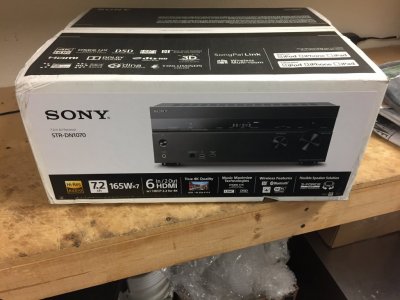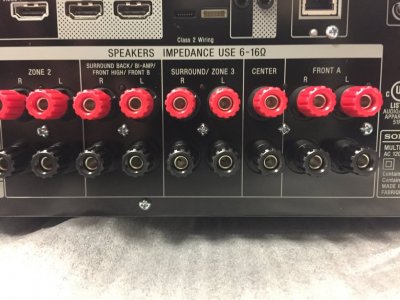ZachsHT
Auditioning
- Joined
- Nov 30, 2016
- Messages
- 9
- Real Name
- Zachary
Hello everyone, I'm new to this forum and pretty much new to home theater (other than connecting 20 speakers to a crappy stereo when I was a kid).
I recently bought a new AVR
(Sony str-dn1070) and a psw-108 Polk audio subwoofer.
Now I'm on the hunt for speakers.
My AVR has multi channel capabilities but I just want to use it as a single for my living room. I'd like to keep them all the same brand (besides the sub and AVR obviously). Hoping to pay around 150$-350 per speaker but will pay a little more if you think it's worth it and better for my set up.
That being said I have some noob questions.
1. What kind of cables do I need for my whole theater set up? the speaker wire (brand of quality), hook up for the subwoofer and everything you think I'll need. besides hdmi.
2. My AVR is a 7.2ch. Since I'm not using it for multi channel how many speakers do I need to utilize all channels?
3. My sub has outputs on it, what are they actually for? Can I run extra speakers off of it or just speakers included in how many channels I have?
4. My AVR has 2 sub out puts. With the sound of my living room being mid-sized. Would I be better off getting 2 smaller subs or one large one. (I prefer low carrying bass over accurate punchy bass).
These are just what's on my mind now, anything for a beginner you think I need to know for installing my HT myself would be much appreciated!
Thanks.
I recently bought a new AVR
(Sony str-dn1070) and a psw-108 Polk audio subwoofer.
Now I'm on the hunt for speakers.
My AVR has multi channel capabilities but I just want to use it as a single for my living room. I'd like to keep them all the same brand (besides the sub and AVR obviously). Hoping to pay around 150$-350 per speaker but will pay a little more if you think it's worth it and better for my set up.
That being said I have some noob questions.
1. What kind of cables do I need for my whole theater set up? the speaker wire (brand of quality), hook up for the subwoofer and everything you think I'll need. besides hdmi.
2. My AVR is a 7.2ch. Since I'm not using it for multi channel how many speakers do I need to utilize all channels?
3. My sub has outputs on it, what are they actually for? Can I run extra speakers off of it or just speakers included in how many channels I have?
4. My AVR has 2 sub out puts. With the sound of my living room being mid-sized. Would I be better off getting 2 smaller subs or one large one. (I prefer low carrying bass over accurate punchy bass).
These are just what's on my mind now, anything for a beginner you think I need to know for installing my HT myself would be much appreciated!
Thanks.
Attachments
Last edited:







